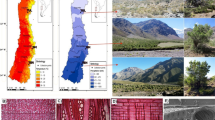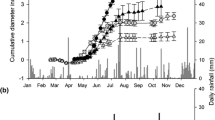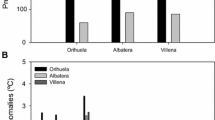Abstract
Key message
The retrospective analysis of wood anatomical features evidences how a long-term deterioration of hydraulic performance and carbon use portend drought-induced mortality in Scots pine.
Abstract
Widespread episodes of drought-induced tree mortality are predicted to become more frequent as climate becomes warmer and drier. Nevertheless, growth trends and their links to changes in wood anatomy before tree dies are still poorly understood. Wood anatomical features provide valuable information that can be extracted to infer the mechanisms leading to tree death. In this study, we characterize drought-induced mortality affecting two Scots pine (Pinus sylvestris) sites (Prades and Arcalís) located in the North Eastern Iberian Peninsula. Co-occurring now-dead and living Scots pine trees were sampled and their wood anatomical features were measured and compared. We aimed to detect differences in anatomical features between living and dead trees, and to infer past physiological performances that might have determined their subsequent death or survival. Now-dead trees showed lower tracheid and resin duct production, and smaller radial lumen diameters than co-occurring living trees. At the more xeric Prades site, these anatomical differences were larger and chronic, i.e. were observed over the three studied decades, whilst they were less pronounced at the other, more mesic Arcalís site, where tree mortality episodes were more recent. This indicates that dead trees’ hydraulic conductivity was severely affected and that carbon investment in xylem formation and resin duct production was constrained prior to tree death. Our findings show that both hydraulic deterioration and low carbon allocation to xylem formation were associated to drought-induced mortality in Scots pine. Nevertheless, the temporal dynamics of these processes differed between populations as a function of site climatic conditions.



Similar content being viewed by others
References
Allen CD, Macalady AK, Chenchouni H, Bachelet D, McDowell N, Vennetier M, Kitzberger T, Rigling A, Breshears DD et al (2010) A global overview of drought and heat-induced tree mortality reveals emerging climate change risks for forests. For Ecol Manage 259:660–684
Anderegg WRL, Berry JA, Field CB (2012) Linking definitions, mechanisms, and modelling of drought-induced tree death. Trends Plant Sci 17:693–700
Anderegg WRL, Plavcova L, Anderegg LDL, Hacke UG, Berry JA, Field CB (2013) Drought’s legacy: multiyear hydraulic deterioration underlies widespread aspen forest die-off and portends increased future risk. Global Ch Biol 19:1188–1196
Barbéro M, Loisel R, Quézel P, Richardson DM, Romane F (1998) Pines of the Mediterranean basin. In: Richardson DM (ed) Ecology and biogeography of Pinus. Cambridge University Press, Cambridge, pp 153–170
Bigler C, Bräker OU, Bugmann H, Dobbertin M, Rigling A (2006) Drought as an inciting mortality factor in Scots pine stands of the Valais, Switzerland. Ecosystems 9:330–343
Bréda N, Huc R, Granier A, Dreyer E (2006) Temperate forest trees and stands under severe drought: a review of ecophysiological responses, adaptation processes and long-term consequences. Ann For Sci 63:625–644
Brodribb TJ, Cochard H (2009) Hydraulic failure defines the recovery and point of death in water-stressed conifers. Plant Physiol 149:575–584
Camarero JJ, Guerrero-Campo J, Gutiérrez E (1998) Tree-ring growth and structure of Pinus uncinata and Pinus sylvestris in the Central Spanish Pyrenees. Arct Alp Res 30:1–10
Camarero JJ, Olano JM, Parras A (2010) Plastic bimodal xylogenesis in conifers from continental Mediterranean climates. New Phytol 185:471–480
Camarero JJ, Sangüesa Barreda G, Alla AQ, González de Andrés E, Maestro Martínez M, Vicente-Serrano SM (2012) Los precedentes y las respuestas de los árboles a sequías extremas revelan los procesos involucrados en el decaimiento de bosques mediterráneos de coníferas. Ecosistemas 21:22–30
Catalan Bachiller G, Gil Muñoz P, Galera Peral RM, Martin Albertos S, Agundez Leal D, Alia Miranda R (1991) Las regiones de procedencia de Pinus sylvestris L. y Pinus nigra Arn. subsp. salzmannii (Dunal) Franco de España. INIA-ICONA, Madrid
Cherubini P, Gartner BL, Tognetti R, Bräker OU, Schoch W, Innes JL (2003) Identification, measurement and interpretation of tree rings in woody species from Mediterranean climates. Biol Rev 78:119–148
Choat B, Jansen S, Brodribb TJ, Cochard H, Delzon S, Bhaskar R, Bucci SJ et al (2012) Global convergence in the vulnerability of forests to drought. Nature 491:752–755
Cochard H (1992) Vulnerability of several conifers to air embolism. Tree Physiol 11:73–83
Cochard H, Froux F, Mayr S, Coutand C (2004) Xylem wall collapse in water-stressed pine needles. Plant Physiol 134:401–408
Denne MP (1988) Definition of latewood according to Mork (1928). IAWA Bull 10:59–62
Denne MP, Dodd RS (1981) The environmental control of xylem differentiation. In: Barnett JR (ed) Xylem cell development. Castle House, Kent, pp 236–255
Eilmann B, Weber P, Rigling A, Eckstein D (2006) Growth reactions of Pinus sylvestris L. and Quercus pubescens Willd. to drought years at a xeric site in Valais Switzerland. Dendrochronologia 23:121–132
Eilmann B, Zweifel R, Buchmann N, Fonti P, Rigling A (2009) Drought-induced adaptation of the xylem in Scots pine and pubescent oak. Tree Physiol 29:1011–1020
Fonti P, von Arx G, García-González I, Eilmann B, Sass-Klaassen U, Gärtner H, Eckstein D (2010) Studying global change through investigation of the plastic responses of xylem anatomy in tree rings. New Phytol 185:42–53
Fritts HC (2001) Tree rings and climate. Blackburn Press, New Jersey
Galiano L, Martínez-Vilalta J, Lloret F (2010) Drought-induced multifactor decline of Scots pine in the Pyrenees and potential vegetation change by the expansion of co-occurring oak species. Ecosystems 13:978–991
Galiano L, Martínez-Vilalta J, Lloret F (2011) Carbon reserves and canopy defoliation determine the recovery of Scots pine 4 yr after a drought episode. New Phytol 190:750–759
Gaylord ML, Kolb TE, Pockman WT, Plaut JA, Yepez EA, Macalady AK, Pangle RE, McDowell NG (2013) Drought predisposes piñon-juniper woodlands to insect attack and mortality. New Phytol 198:567–578
Giorgi F, Lionello P (2008) Climate change projections for the Mediterranean region. Glob Planet Ch 63:90–104
Hacke UG, Sperry JS, Pockman WT, Davis SD, McCulloh KA (2001) Trends in wood density and structure are linked to prevention of xylem implosion by negative pressure. Oecologia 126:457–461
Hargreaves GH, Samani ZA (1982) Estimating potential evapotranspiration. J Irrig Drain Div ASCE 108:225–230
Hereş AM, Martínez-Vilalta J, Claramunt López B (2012) Growth patterns in relation to drought-induced mortality at two Scots pine (Pinus sylvestris L.) sites in NE Iberian Peninsula. Trees Str Funct 26:621–630
Hereter A, Sánchez JR (1999) Experimental areas of Prades and Montseny. In: Bellot J, Rodà F, Retana J, Gracia CA (eds) Ecology of Mediterranean evergreen Oak forests. Springer, Germany, pp 15–27
Hsiao TC, Acevedo E (1974) Plant responses to water deficits, water-use efficiency, and drought resistance. Agric Meteorol 14:59–84
IPCC (2013) Climate Change 2013: the Physical Science Basis. Contribution of Working Group I to the Fifth Assessment Report of the Intergovernmental Panel on Climate Change. Cambridge University Press, Cambridge
Irvine J, Perks MP, Magnani F, Grace J (1998) The response of Pinus sylvestris to drought: stomatal control of transpiration and hydraulic conductance. Tree Physiol 18:393–402
Kane JM, Kolb TE (2010) Importance of resin ducts in reducing ponderosa pine mortality from bark beetle attack. Oecologia 164:601–609
Köppen W (1936) Das Geographische System der Klimate. In: Köppen W, Geiger R (eds) Handbuch der Klimatologie. Gebrüder Borntraeger, Berlin, pp 1–44
Levanič T, Čater M, McDowell NG (2011) Associations between growth, wood anatomy, carbon isotope discrimination and mortality in a Quercus robur forest. Tree Physiol 31:298–308
Martin-Benito D, Beeckman H, Cañellas I (2013) Influence of drought on tree rings and tracheid features of Pinus nigra and Pinus sylvestris in a mesic Mediterranean forest. Eur J For Res 132:33–45
Martínez-Vilalta J, Piñol J (2002) Drought-induced mortality and hydraulic architecture in pine populations of the NE Iberian Peninsula. For Ecol Manage 161:247–256
Martínez-Vilalta J, López BC, Adell N, Badiella L, Ninyerola M (2008) Twentieth century increase of Scots pine radial growth in NE Spain shows strong climate interactions. Glob Ch Biol 14:1–14
Martínez-Vilalta J, Cochard H, Mencuccini M, Sterck F, Herrero A, Korhonen JFJ, Llorens P, Nikinmaa E, Nolè A, Poyatos R, Ripullone F, Sass-Klaassen U, Zweifel R (2009) Hydraulic adjustments of Scots pine across Europe. New Phytol 184:353–364
Martínez-Vilalta J, Aguadé D, Banqué M, Barba J, Curiel Yuste J, Galiano L, Garcia N, Gómez M, Hereş AM, López BC, Lloret F, Poyatos R, Retana J, Sus O, Vayreda J, Vilà-Cabrera A (2012) Las poblaciones ibéricas de pino albar ante el cambio climático: con la muerte en los talones. Ecosistemas 21:15–21
Martίn JA, Esteban LG, de Palacios P, Garcίa Fernández F (2010) Variation in wood anatomical traits of Pinus sylvestris L. between Spanish regions of provenance. Trees Str Funct 24:1017–1028
Matías L, Jump AS (2012) Interactions between growth, demography and biotic interactions in determining species range limits in a warming world: the case of Pinus sylvestris. For Ecol Manage 282:10–22
Matlab (2010) Mathworks Company, Version 7.10 R2010a. Natick, Massachusetts
McCarroll D, Loader NJ (2004) Stable isotopes in tree rings. Quat Sci Rev 23:771–801
McDowell NG (2011) Mechanisms linking drought, hydraulics, carbon metabolism, and vegetation mortality. Plant Physiol 155:1051–1059
McDowell NG, Sevanto S (2010) The mechanisms of carbon starvation: how, when, or does it even occur at all? New Phytol 186:264–266
McDowell N, Pockman WT, Allen CD, Breshears DD, Cobb N, Kolb T, Plaut J, Sperry J, West A, Williams DG, Yepez EA (2008) Mechanisms of plant survival and mortality during drought: why do some plants survive while others succumb to drought? New Phytol 178:719–739
McDowell NG, Beerling DJ, Breshears DD, Fisher RA, Raffa KF, Stitt M (2011) The interdependence of mechanisms underlying climate-driven vegetation mortality. Trends Ecol Evol 26:523–532
Nikolov N, Helmisaari H (1992) Silvics of the circumpolar boreal forest tree species. In: Shugart H, Leemans R, Bowan G (eds) A systems analysis of the global boreal forest. Cambridge University Press, Cambridge, pp 13–84
Ninyerola M, Pons X, Roure JM (2000) A methodological approach of climatological modeling of air temperature and precipitation through GIS techniques. Int J Climatol 20:1823–1841
Ninyerola M, Pons X, Roure JM (2007a) Monthly precipitation mapping of the Iberian Peninsula using spatial interpolation tools implemented in a geographic information system. Theor Appl Climatol 89:195–209
Ninyerola M, Pons X, Roure JM (2007b) Objective air temperature mapping for the Iberian Peninsula using spatial interpolation and GIS. Int J Climatol 27:1231–1242
Ogle K, Whitham TG, Cobb NS (2000) Tree-ring variation in pinyon predicts likelihood of death following severe drought. Ecology 81:3237–3243
Paine TD, Raffa KF, Harrington TC (1997) Interactions among scolytid bark beetles, their association fungi, and live host conifers. Ann Rev Entomol 42:179–206
Pasho E, Camarero JJ, de Luis M, Vicente-Serrano SM (2011) Impacts of drought at different time scales on forest growth across a wide climatic gradient in north-eastern Spain. Agric For Meteorol 151:1800–1811
Piñol J, Terradas J, Lloret F (1998) Climate warming, wildfire hazard, and wildfire occurrence in coastal Eastern Spain. Clim Ch 38:345–357
Pons X (1996) Estimación de la radiación solar a partir de modelos digitales de elevaciones. Propuesta metodológica. In: Juaristi J, Moro I (eds) VII Coloquio de Geografía Cuantitativa. Sistemas de Información Geográfica y Teledetección, Vitoria-Gasteiz, Spain, pp 87–97
Poyatos R, Aguadé D, Galiano L, Mencuccini M, Martínez-Vilalta J (2013) Drought-induced defoliation and long periods of near-zero gas exchange play a key role in accentuating metabolic decline of Scots pine. New Phytol 200:388–401
R (2013) R: A language and environment for statistical computing, Version 3.0. R foundation for statistical computing. Vienna, Austria
Rigling A, Brühlhart H, Bräker OU, Forster T, Schweingruber FH (2003) Effects of irrigation on diameter growth and vertical resin duct production in Pinus sylvestris L. on dry sites in the central Alps Switzerland. For Ecol Manage 175:285–296
Rigling A, Bigler C, Eilmann B, Feldmeyer-Christe E, Gimmi U, Ginzler C, Graf U, Mayer P, Vacchiano G, Weber P, Wohlgemuth T, Zweifel R, Dobbertin M (2013) Driving factors of a vegetation shift from Scots pine to pubescent oak in dry Alpine forests. Glob Ch Biol 19:229–240
Robertson A, Overpeck J, Rind D, Mosley-Thompson E, Zielinski G, Lean J, Koch D, Penner J, Tegen I, Healy R (2001) Hypothesized climate forcing time series for the last 500 years. J Geophys Res 106:14783–14803
Sala A, Piper F, Hoch G (2010) Physiological mechanisms of drought-induced tree mortality are far from being resolved. New Phytol 186:274–281
Sala A, Woodruff DR, Meinzer FC (2012) Carbon dynamics in trees: feast or famine? Tree Physiol 32:764–775
Seo J-W, Smiljanić M, Wilmking M (2014) Optimizing cell-anatomical chronologies of Scots pine by stepwise increasing the number of radial tracheid rows included—Case study based on three Scandinavian sites. Dendrochronologia 32:205–209
Sevanto S, McDowell NG, Dickman LT, Pangle R, Pockman WT (2014) How do trees die? A test of the hydraulic failure and carbon starvation hypotheses. Plant, Cell Environ 37:153–161
SPSS (2006) IBM Company, Version 15.0. Chicago, Illinois
Tyree MT, Zimmerman MH (2002) Xylem structure and the ascent of sap. Springer, New York
Vaganov EA (1990) The tracheidogram method in tree-ring analysis and its application. In: Cook ER, Kairiukstis LA (eds) Methods of dendrochronology: applications in the environmental sciences. Kluwer Academic Publishers, Dordrecht, pp 63–76
Vaganov EA, Hughes MK, Shashkin AV (2006) Growth dynamics of conifer tree rings: images of past and future environments. Springer, New York
Vicente-Serrano SM, Beguerίa S, López-Moreno JI (2010a) A multi-scalar drought index sensitive to global warming: the standardized precipitation evapotranspiration index. J Clim 23:1696–1718
Vicente-Serrano SM, Beguerίa S, López-Moreno JI, Angulo M, El Kenawy A (2010b) A new global 0.5° gridded dataset (1901–2006) of a multiscalar drought index: comparison with current drought index datasets based on the Palmer drought severity index. J Hydrometeorol 11:1033–1043
Vilà-Cabrera A, Martínez-Vilalta J, Galiano L, Retana J (2013) Patterns of forest decline and regeneration across Scots pine populations. Ecosystems 16:323–335
Vilà-Cabrera A, Martínez-Vilalta J, Retana J (2014) Variation in reproduction and growth in declining Scots pine populations. Persp Plant Ecol Evol Syst 16:111–120
von Wilpert K (1991) Intraannual variation of radial tracheid diameters as monitor of site specific water stress. Dendrochronologia 9:95–113
Vysotskaya LG, Vaganov EA (1989) Components of the variability of radial cell size in tree rings of conifers. IAWA Bull 10:417–428
Waring RH (1987) Characteristics of trees predisposed to die. Bioscience 37:569–574
Wimmer R (2002) Wood anatomical features in tree-rings as indicators of environmental change. Dendrochronologia 20:21–36
Zweifel R, Zimmermann L, Zeugin F, Newbery DM (2006) Intra-annual radial growth and water relations of trees: implications towards a growth mechanism. J Exp Bot 57:1445–1459
Acknowledgments
The authors thank H.A. Chaparro, A.Q. Alla, E. Pasho and M.C. Sancho for laboratory assistance. We also thank Debora Gil, who wrote all the Matlab codes for DACiA development. We are indebted to M. Mencuccini for field work and valuable discussions. The authors are also thankful to M. Ninyerola and the Catalan Meteorological Service for providing the two climatic datasets used in this study. Special thanks to M. Mejia-Chang for being part of our lives and a great inspiration for us all. This research was funded by the Spanish Ministry of Science and Innovation (projects CGL2007-60120, CSD2008-0040, CGL2010-16373, CGL2011-26654), a FPU PhD scholarship and a short stay at the IPE (CSIC).
Conflict of interest
The authors declare that they have no conflict of interest.
Author information
Authors and Affiliations
Corresponding author
Additional information
Communicated by E. Liang.
Electronic supplementary material
Below is the link to the electronic supplementary material.
Rights and permissions
About this article
Cite this article
Hereş, AM., Camarero, J.J., López, B.C. et al. Declining hydraulic performances and low carbon investments in tree rings predate Scots pine drought-induced mortality. Trees 28, 1737–1750 (2014). https://doi.org/10.1007/s00468-014-1081-3
Received:
Accepted:
Published:
Issue Date:
DOI: https://doi.org/10.1007/s00468-014-1081-3




